Case Study and Care Plan: Application of Nursing Care for the Elderly
VerifiedAdded on 2022/09/18
|11
|3118
|21
Case Study
AI Summary
This case study and care plan examines the health of a 69-year-old elderly man named Hervey, encountered during a clinical placement. Hervey presented with two significant comorbidities: urinary tract infection (UTI) and dementia, which impacted his functional status. The study explores the impact of these conditions, considering environmental factors like temperature sensitivity, and the influence of negative stereotypes associated with aging. The care plan prioritizes assessment of Hervey's physical, emotional, and cognitive abilities, outlining both short-term and long-term outcomes. Nursing interventions include health promotion, dependent interventions, and interdependent interventions involving various healthcare professionals like nutritionists. The evaluation criteria focus on nursing diagnosis, subjective data, objective data, and goal achievement, with a timeline including the patient's hospital stay and the week following discharge. The plan emphasizes evidence-based practice and the need for appropriate treatment tailored to the elderly patient's specific needs, aiming to reduce pain and promote recovery.
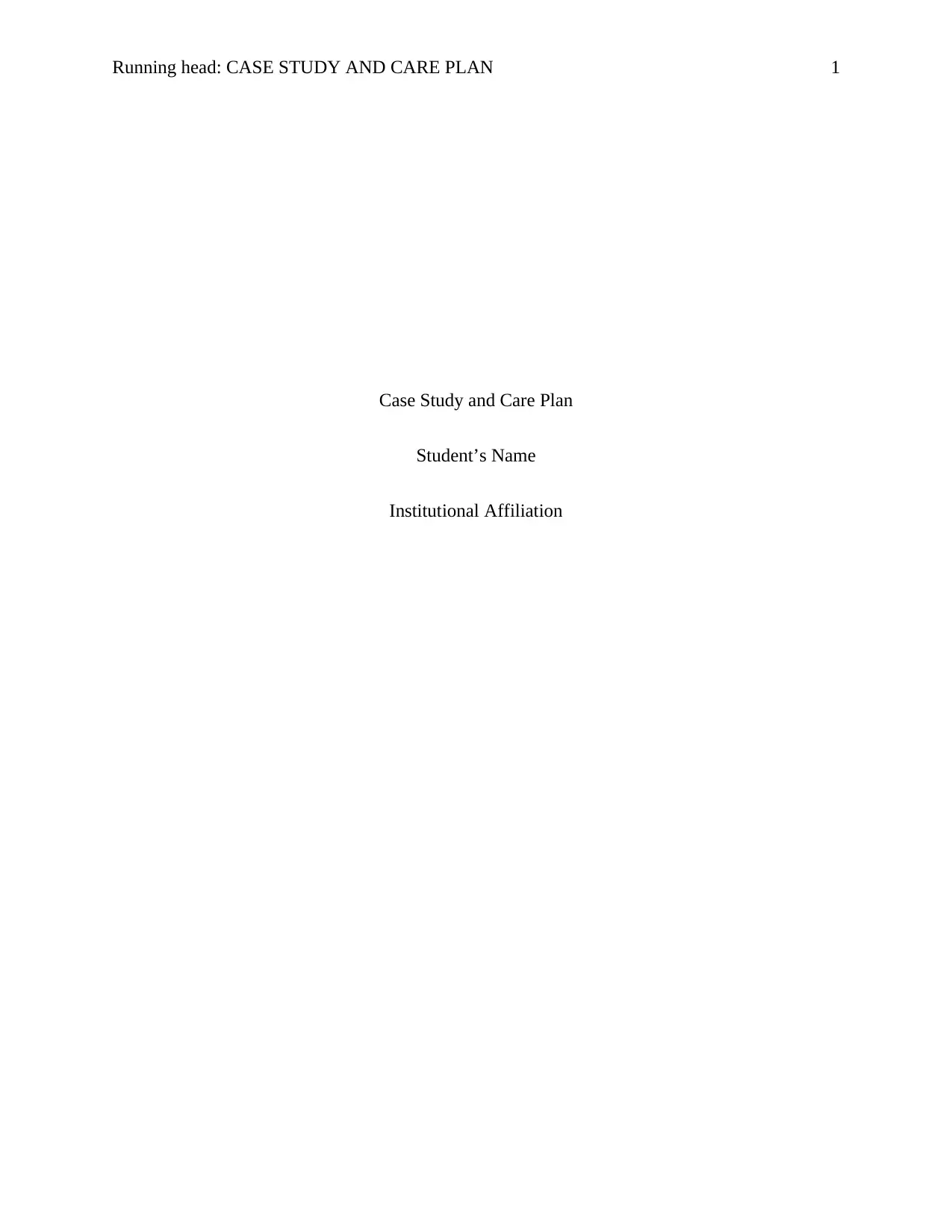
Running head: CASE STUDY AND CARE PLAN 1
Case Study and Care Plan
Student’s Name
Institutional Affiliation
Case Study and Care Plan
Student’s Name
Institutional Affiliation
Paraphrase This Document
Need a fresh take? Get an instant paraphrase of this document with our AI Paraphraser
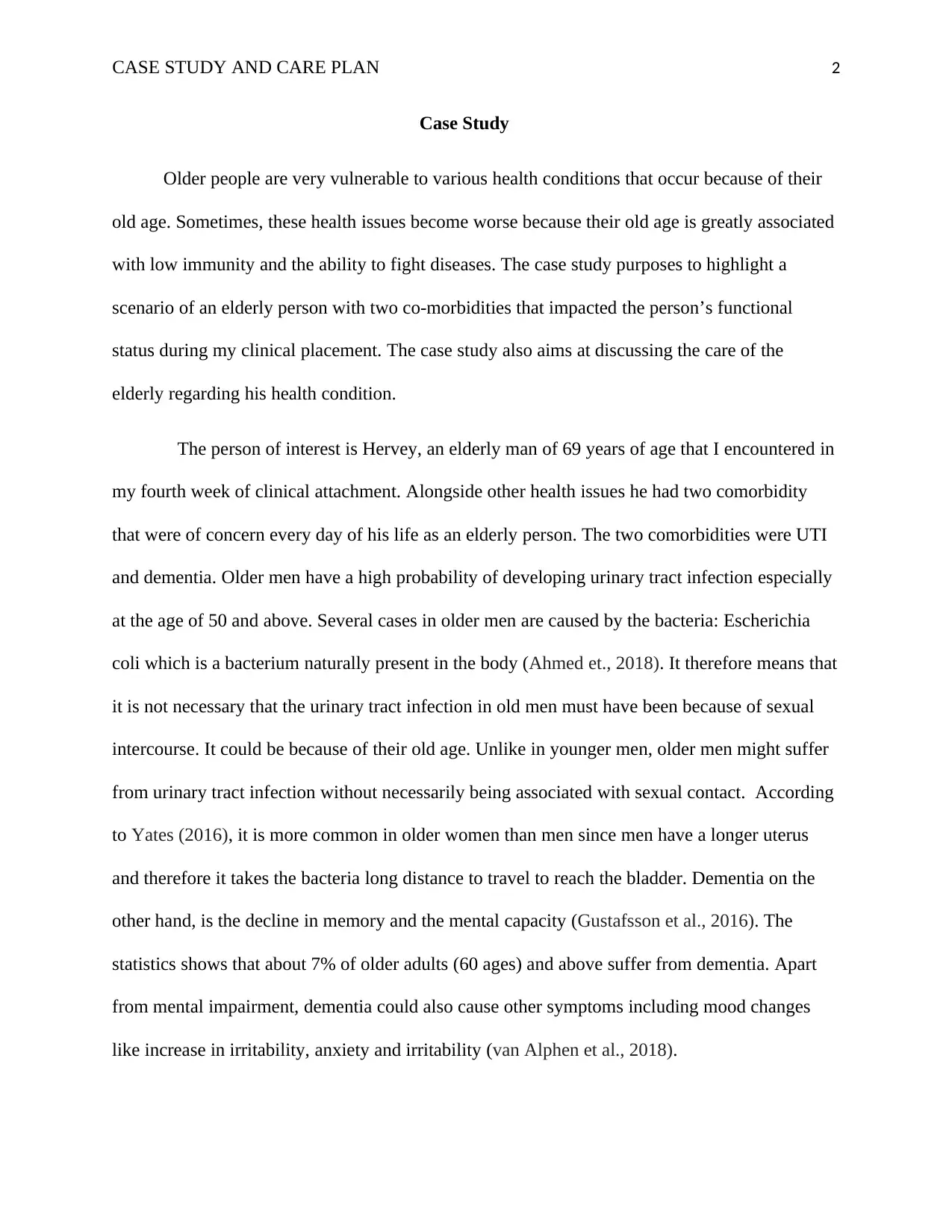
CASE STUDY AND CARE PLAN 2
Case Study
Older people are very vulnerable to various health conditions that occur because of their
old age. Sometimes, these health issues become worse because their old age is greatly associated
with low immunity and the ability to fight diseases. The case study purposes to highlight a
scenario of an elderly person with two co-morbidities that impacted the person’s functional
status during my clinical placement. The case study also aims at discussing the care of the
elderly regarding his health condition.
The person of interest is Hervey, an elderly man of 69 years of age that I encountered in
my fourth week of clinical attachment. Alongside other health issues he had two comorbidity
that were of concern every day of his life as an elderly person. The two comorbidities were UTI
and dementia. Older men have a high probability of developing urinary tract infection especially
at the age of 50 and above. Several cases in older men are caused by the bacteria: Escherichia
coli which is a bacterium naturally present in the body (Ahmed et., 2018). It therefore means that
it is not necessary that the urinary tract infection in old men must have been because of sexual
intercourse. It could be because of their old age. Unlike in younger men, older men might suffer
from urinary tract infection without necessarily being associated with sexual contact. According
to Yates (2016), it is more common in older women than men since men have a longer uterus
and therefore it takes the bacteria long distance to travel to reach the bladder. Dementia on the
other hand, is the decline in memory and the mental capacity (Gustafsson et al., 2016). The
statistics shows that about 7% of older adults (60 ages) and above suffer from dementia. Apart
from mental impairment, dementia could also cause other symptoms including mood changes
like increase in irritability, anxiety and irritability (van Alphen et al., 2018).
Case Study
Older people are very vulnerable to various health conditions that occur because of their
old age. Sometimes, these health issues become worse because their old age is greatly associated
with low immunity and the ability to fight diseases. The case study purposes to highlight a
scenario of an elderly person with two co-morbidities that impacted the person’s functional
status during my clinical placement. The case study also aims at discussing the care of the
elderly regarding his health condition.
The person of interest is Hervey, an elderly man of 69 years of age that I encountered in
my fourth week of clinical attachment. Alongside other health issues he had two comorbidity
that were of concern every day of his life as an elderly person. The two comorbidities were UTI
and dementia. Older men have a high probability of developing urinary tract infection especially
at the age of 50 and above. Several cases in older men are caused by the bacteria: Escherichia
coli which is a bacterium naturally present in the body (Ahmed et., 2018). It therefore means that
it is not necessary that the urinary tract infection in old men must have been because of sexual
intercourse. It could be because of their old age. Unlike in younger men, older men might suffer
from urinary tract infection without necessarily being associated with sexual contact. According
to Yates (2016), it is more common in older women than men since men have a longer uterus
and therefore it takes the bacteria long distance to travel to reach the bladder. Dementia on the
other hand, is the decline in memory and the mental capacity (Gustafsson et al., 2016). The
statistics shows that about 7% of older adults (60 ages) and above suffer from dementia. Apart
from mental impairment, dementia could also cause other symptoms including mood changes
like increase in irritability, anxiety and irritability (van Alphen et al., 2018).
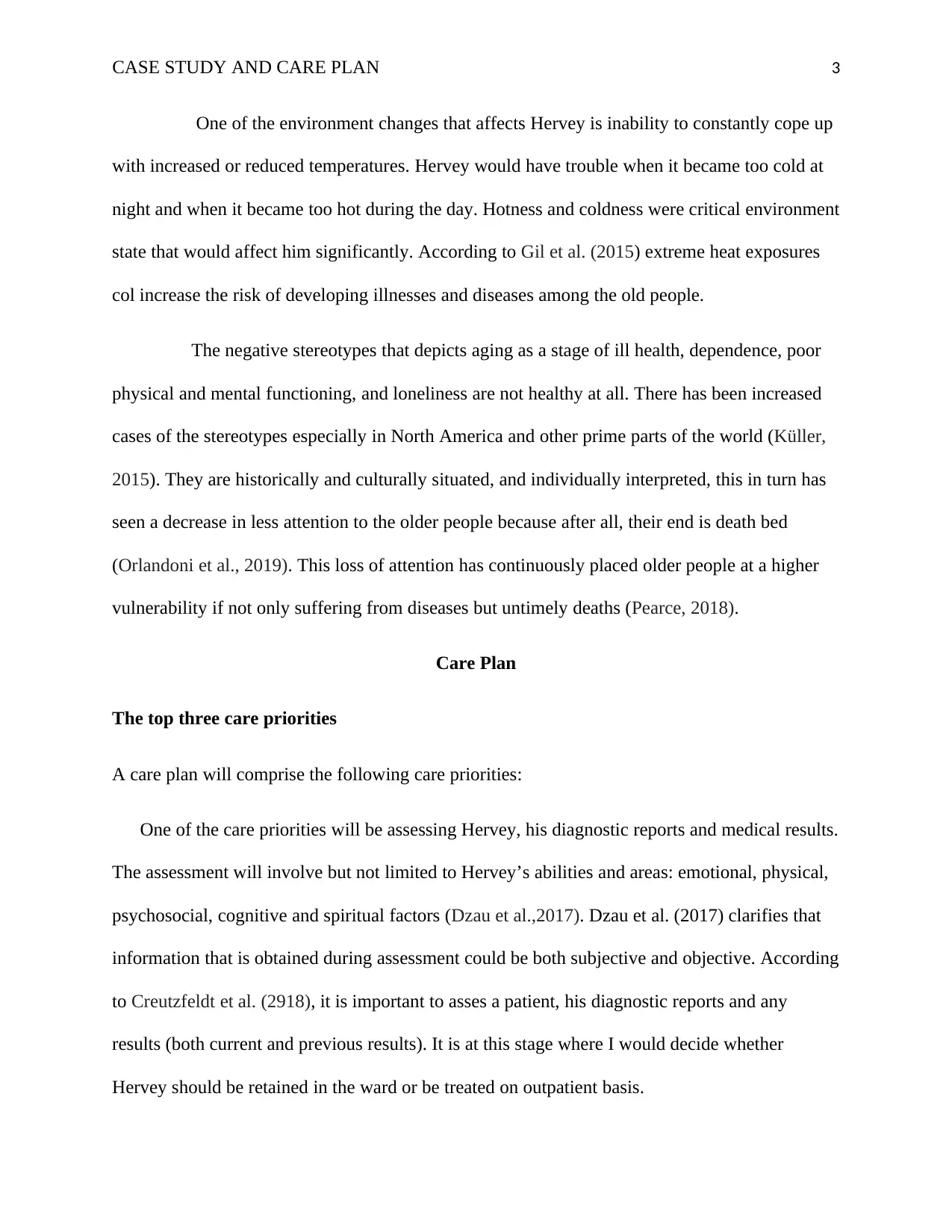
CASE STUDY AND CARE PLAN 3
One of the environment changes that affects Hervey is inability to constantly cope up
with increased or reduced temperatures. Hervey would have trouble when it became too cold at
night and when it became too hot during the day. Hotness and coldness were critical environment
state that would affect him significantly. According to Gil et al. (2015) extreme heat exposures
col increase the risk of developing illnesses and diseases among the old people.
The negative stereotypes that depicts aging as a stage of ill health, dependence, poor
physical and mental functioning, and loneliness are not healthy at all. There has been increased
cases of the stereotypes especially in North America and other prime parts of the world (Küller,
2015). They are historically and culturally situated, and individually interpreted, this in turn has
seen a decrease in less attention to the older people because after all, their end is death bed
(Orlandoni et al., 2019). This loss of attention has continuously placed older people at a higher
vulnerability if not only suffering from diseases but untimely deaths (Pearce, 2018).
Care Plan
The top three care priorities
A care plan will comprise the following care priorities:
One of the care priorities will be assessing Hervey, his diagnostic reports and medical results.
The assessment will involve but not limited to Hervey’s abilities and areas: emotional, physical,
psychosocial, cognitive and spiritual factors (Dzau et al.,2017). Dzau et al. (2017) clarifies that
information that is obtained during assessment could be both subjective and objective. According
to Creutzfeldt et al. (2918), it is important to asses a patient, his diagnostic reports and any
results (both current and previous results). It is at this stage where I would decide whether
Hervey should be retained in the ward or be treated on outpatient basis.
One of the environment changes that affects Hervey is inability to constantly cope up
with increased or reduced temperatures. Hervey would have trouble when it became too cold at
night and when it became too hot during the day. Hotness and coldness were critical environment
state that would affect him significantly. According to Gil et al. (2015) extreme heat exposures
col increase the risk of developing illnesses and diseases among the old people.
The negative stereotypes that depicts aging as a stage of ill health, dependence, poor
physical and mental functioning, and loneliness are not healthy at all. There has been increased
cases of the stereotypes especially in North America and other prime parts of the world (Küller,
2015). They are historically and culturally situated, and individually interpreted, this in turn has
seen a decrease in less attention to the older people because after all, their end is death bed
(Orlandoni et al., 2019). This loss of attention has continuously placed older people at a higher
vulnerability if not only suffering from diseases but untimely deaths (Pearce, 2018).
Care Plan
The top three care priorities
A care plan will comprise the following care priorities:
One of the care priorities will be assessing Hervey, his diagnostic reports and medical results.
The assessment will involve but not limited to Hervey’s abilities and areas: emotional, physical,
psychosocial, cognitive and spiritual factors (Dzau et al.,2017). Dzau et al. (2017) clarifies that
information that is obtained during assessment could be both subjective and objective. According
to Creutzfeldt et al. (2918), it is important to asses a patient, his diagnostic reports and any
results (both current and previous results). It is at this stage where I would decide whether
Hervey should be retained in the ward or be treated on outpatient basis.
⊘ This is a preview!⊘
Do you want full access?
Subscribe today to unlock all pages.

Trusted by 1+ million students worldwide
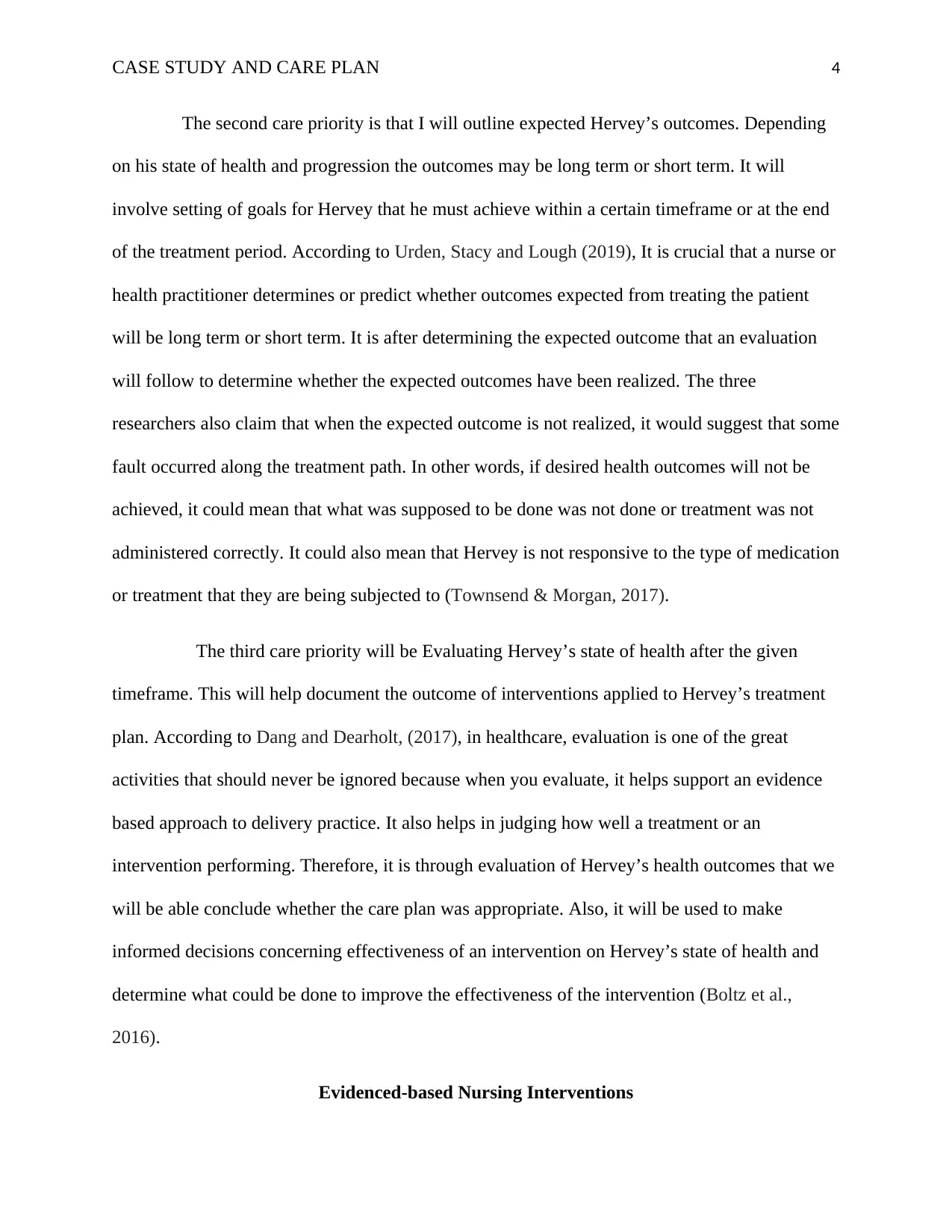
CASE STUDY AND CARE PLAN 4
The second care priority is that I will outline expected Hervey’s outcomes. Depending
on his state of health and progression the outcomes may be long term or short term. It will
involve setting of goals for Hervey that he must achieve within a certain timeframe or at the end
of the treatment period. According to Urden, Stacy and Lough (2019), It is crucial that a nurse or
health practitioner determines or predict whether outcomes expected from treating the patient
will be long term or short term. It is after determining the expected outcome that an evaluation
will follow to determine whether the expected outcomes have been realized. The three
researchers also claim that when the expected outcome is not realized, it would suggest that some
fault occurred along the treatment path. In other words, if desired health outcomes will not be
achieved, it could mean that what was supposed to be done was not done or treatment was not
administered correctly. It could also mean that Hervey is not responsive to the type of medication
or treatment that they are being subjected to (Townsend & Morgan, 2017).
The third care priority will be Evaluating Hervey’s state of health after the given
timeframe. This will help document the outcome of interventions applied to Hervey’s treatment
plan. According to Dang and Dearholt, (2017), in healthcare, evaluation is one of the great
activities that should never be ignored because when you evaluate, it helps support an evidence
based approach to delivery practice. It also helps in judging how well a treatment or an
intervention performing. Therefore, it is through evaluation of Hervey’s health outcomes that we
will be able conclude whether the care plan was appropriate. Also, it will be used to make
informed decisions concerning effectiveness of an intervention on Hervey’s state of health and
determine what could be done to improve the effectiveness of the intervention (Boltz et al.,
2016).
Evidenced-based Nursing Interventions
The second care priority is that I will outline expected Hervey’s outcomes. Depending
on his state of health and progression the outcomes may be long term or short term. It will
involve setting of goals for Hervey that he must achieve within a certain timeframe or at the end
of the treatment period. According to Urden, Stacy and Lough (2019), It is crucial that a nurse or
health practitioner determines or predict whether outcomes expected from treating the patient
will be long term or short term. It is after determining the expected outcome that an evaluation
will follow to determine whether the expected outcomes have been realized. The three
researchers also claim that when the expected outcome is not realized, it would suggest that some
fault occurred along the treatment path. In other words, if desired health outcomes will not be
achieved, it could mean that what was supposed to be done was not done or treatment was not
administered correctly. It could also mean that Hervey is not responsive to the type of medication
or treatment that they are being subjected to (Townsend & Morgan, 2017).
The third care priority will be Evaluating Hervey’s state of health after the given
timeframe. This will help document the outcome of interventions applied to Hervey’s treatment
plan. According to Dang and Dearholt, (2017), in healthcare, evaluation is one of the great
activities that should never be ignored because when you evaluate, it helps support an evidence
based approach to delivery practice. It also helps in judging how well a treatment or an
intervention performing. Therefore, it is through evaluation of Hervey’s health outcomes that we
will be able conclude whether the care plan was appropriate. Also, it will be used to make
informed decisions concerning effectiveness of an intervention on Hervey’s state of health and
determine what could be done to improve the effectiveness of the intervention (Boltz et al.,
2016).
Evidenced-based Nursing Interventions
Paraphrase This Document
Need a fresh take? Get an instant paraphrase of this document with our AI Paraphraser
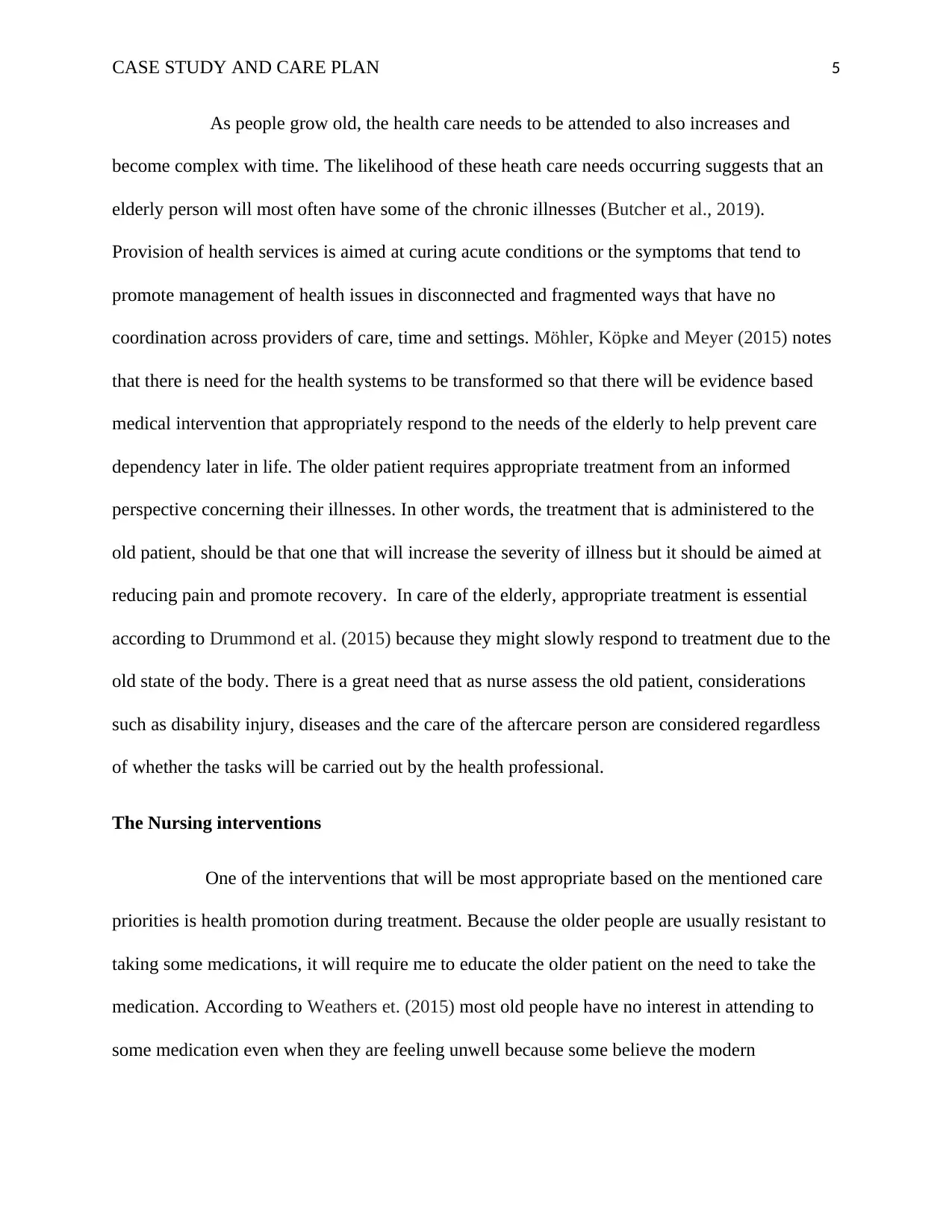
CASE STUDY AND CARE PLAN 5
As people grow old, the health care needs to be attended to also increases and
become complex with time. The likelihood of these heath care needs occurring suggests that an
elderly person will most often have some of the chronic illnesses (Butcher et al., 2019).
Provision of health services is aimed at curing acute conditions or the symptoms that tend to
promote management of health issues in disconnected and fragmented ways that have no
coordination across providers of care, time and settings. Möhler, Köpke and Meyer (2015) notes
that there is need for the health systems to be transformed so that there will be evidence based
medical intervention that appropriately respond to the needs of the elderly to help prevent care
dependency later in life. The older patient requires appropriate treatment from an informed
perspective concerning their illnesses. In other words, the treatment that is administered to the
old patient, should be that one that will increase the severity of illness but it should be aimed at
reducing pain and promote recovery. In care of the elderly, appropriate treatment is essential
according to Drummond et al. (2015) because they might slowly respond to treatment due to the
old state of the body. There is a great need that as nurse assess the old patient, considerations
such as disability injury, diseases and the care of the aftercare person are considered regardless
of whether the tasks will be carried out by the health professional.
The Nursing interventions
One of the interventions that will be most appropriate based on the mentioned care
priorities is health promotion during treatment. Because the older people are usually resistant to
taking some medications, it will require me to educate the older patient on the need to take the
medication. According to Weathers et. (2015) most old people have no interest in attending to
some medication even when they are feeling unwell because some believe the modern
As people grow old, the health care needs to be attended to also increases and
become complex with time. The likelihood of these heath care needs occurring suggests that an
elderly person will most often have some of the chronic illnesses (Butcher et al., 2019).
Provision of health services is aimed at curing acute conditions or the symptoms that tend to
promote management of health issues in disconnected and fragmented ways that have no
coordination across providers of care, time and settings. Möhler, Köpke and Meyer (2015) notes
that there is need for the health systems to be transformed so that there will be evidence based
medical intervention that appropriately respond to the needs of the elderly to help prevent care
dependency later in life. The older patient requires appropriate treatment from an informed
perspective concerning their illnesses. In other words, the treatment that is administered to the
old patient, should be that one that will increase the severity of illness but it should be aimed at
reducing pain and promote recovery. In care of the elderly, appropriate treatment is essential
according to Drummond et al. (2015) because they might slowly respond to treatment due to the
old state of the body. There is a great need that as nurse assess the old patient, considerations
such as disability injury, diseases and the care of the aftercare person are considered regardless
of whether the tasks will be carried out by the health professional.
The Nursing interventions
One of the interventions that will be most appropriate based on the mentioned care
priorities is health promotion during treatment. Because the older people are usually resistant to
taking some medications, it will require me to educate the older patient on the need to take the
medication. According to Weathers et. (2015) most old people have no interest in attending to
some medication even when they are feeling unwell because some believe the modern
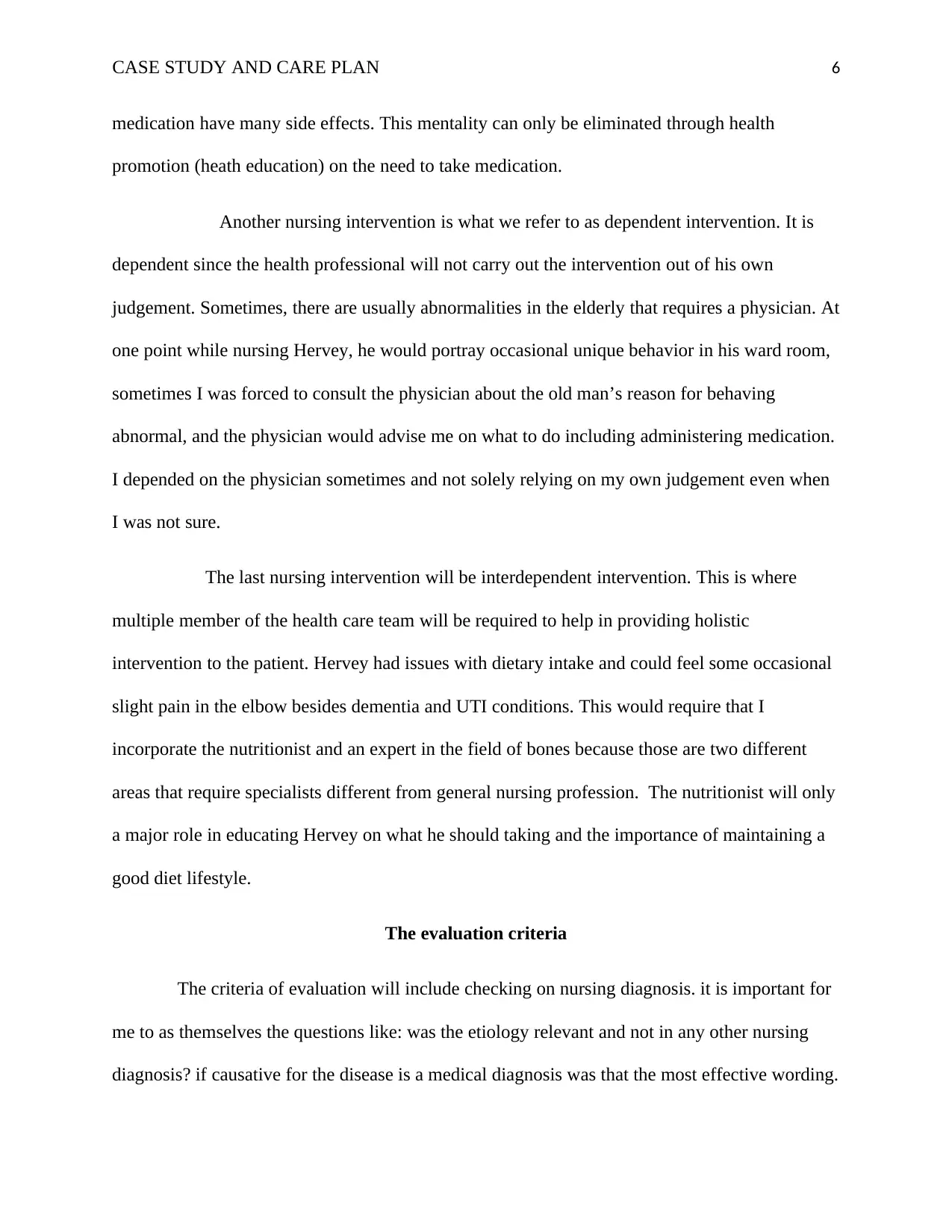
CASE STUDY AND CARE PLAN 6
medication have many side effects. This mentality can only be eliminated through health
promotion (heath education) on the need to take medication.
Another nursing intervention is what we refer to as dependent intervention. It is
dependent since the health professional will not carry out the intervention out of his own
judgement. Sometimes, there are usually abnormalities in the elderly that requires a physician. At
one point while nursing Hervey, he would portray occasional unique behavior in his ward room,
sometimes I was forced to consult the physician about the old man’s reason for behaving
abnormal, and the physician would advise me on what to do including administering medication.
I depended on the physician sometimes and not solely relying on my own judgement even when
I was not sure.
The last nursing intervention will be interdependent intervention. This is where
multiple member of the health care team will be required to help in providing holistic
intervention to the patient. Hervey had issues with dietary intake and could feel some occasional
slight pain in the elbow besides dementia and UTI conditions. This would require that I
incorporate the nutritionist and an expert in the field of bones because those are two different
areas that require specialists different from general nursing profession. The nutritionist will only
a major role in educating Hervey on what he should taking and the importance of maintaining a
good diet lifestyle.
The evaluation criteria
The criteria of evaluation will include checking on nursing diagnosis. it is important for
me to as themselves the questions like: was the etiology relevant and not in any other nursing
diagnosis? if causative for the disease is a medical diagnosis was that the most effective wording.
medication have many side effects. This mentality can only be eliminated through health
promotion (heath education) on the need to take medication.
Another nursing intervention is what we refer to as dependent intervention. It is
dependent since the health professional will not carry out the intervention out of his own
judgement. Sometimes, there are usually abnormalities in the elderly that requires a physician. At
one point while nursing Hervey, he would portray occasional unique behavior in his ward room,
sometimes I was forced to consult the physician about the old man’s reason for behaving
abnormal, and the physician would advise me on what to do including administering medication.
I depended on the physician sometimes and not solely relying on my own judgement even when
I was not sure.
The last nursing intervention will be interdependent intervention. This is where
multiple member of the health care team will be required to help in providing holistic
intervention to the patient. Hervey had issues with dietary intake and could feel some occasional
slight pain in the elbow besides dementia and UTI conditions. This would require that I
incorporate the nutritionist and an expert in the field of bones because those are two different
areas that require specialists different from general nursing profession. The nutritionist will only
a major role in educating Hervey on what he should taking and the importance of maintaining a
good diet lifestyle.
The evaluation criteria
The criteria of evaluation will include checking on nursing diagnosis. it is important for
me to as themselves the questions like: was the etiology relevant and not in any other nursing
diagnosis? if causative for the disease is a medical diagnosis was that the most effective wording.
⊘ This is a preview!⊘
Do you want full access?
Subscribe today to unlock all pages.

Trusted by 1+ million students worldwide
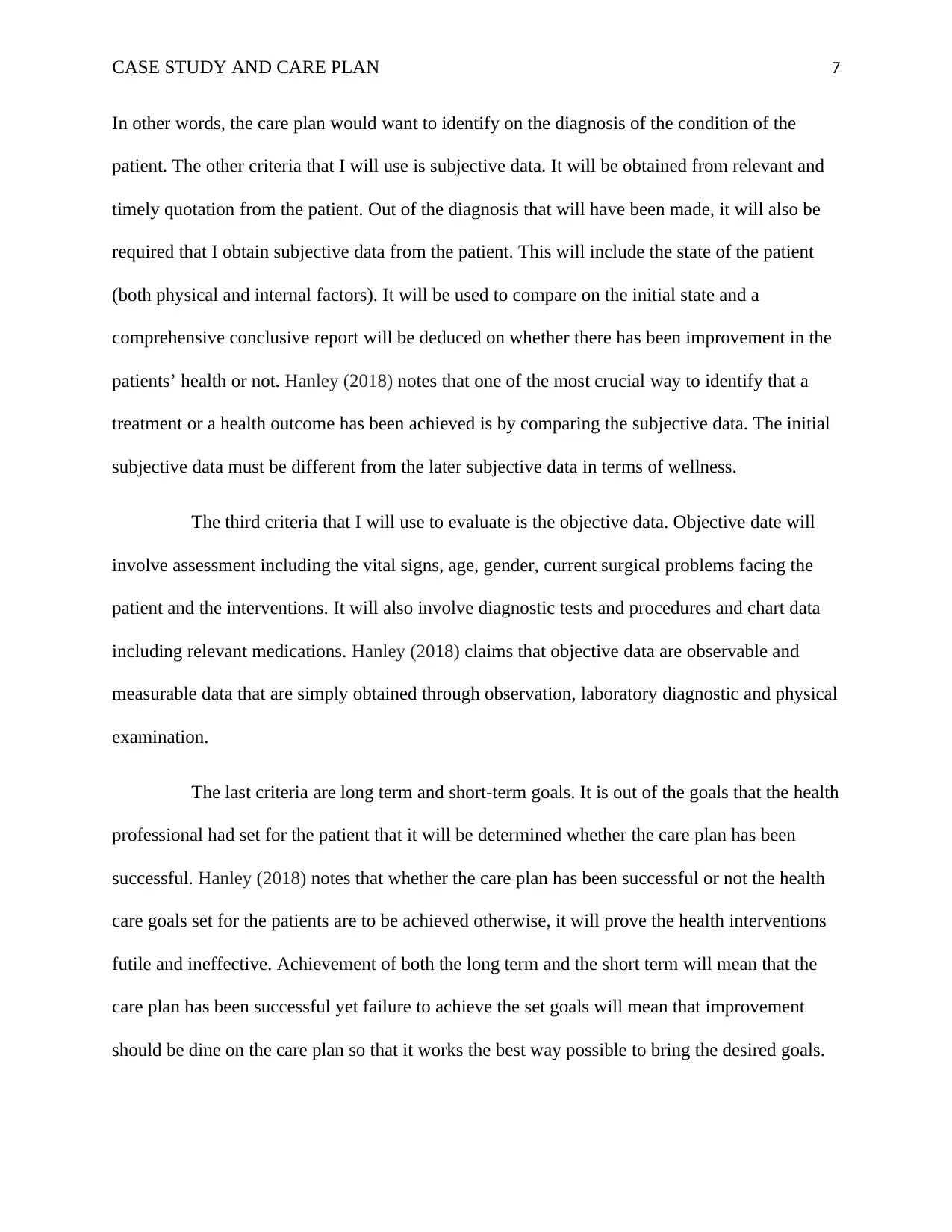
CASE STUDY AND CARE PLAN 7
In other words, the care plan would want to identify on the diagnosis of the condition of the
patient. The other criteria that I will use is subjective data. It will be obtained from relevant and
timely quotation from the patient. Out of the diagnosis that will have been made, it will also be
required that I obtain subjective data from the patient. This will include the state of the patient
(both physical and internal factors). It will be used to compare on the initial state and a
comprehensive conclusive report will be deduced on whether there has been improvement in the
patients’ health or not. Hanley (2018) notes that one of the most crucial way to identify that a
treatment or a health outcome has been achieved is by comparing the subjective data. The initial
subjective data must be different from the later subjective data in terms of wellness.
The third criteria that I will use to evaluate is the objective data. Objective date will
involve assessment including the vital signs, age, gender, current surgical problems facing the
patient and the interventions. It will also involve diagnostic tests and procedures and chart data
including relevant medications. Hanley (2018) claims that objective data are observable and
measurable data that are simply obtained through observation, laboratory diagnostic and physical
examination.
The last criteria are long term and short-term goals. It is out of the goals that the health
professional had set for the patient that it will be determined whether the care plan has been
successful. Hanley (2018) notes that whether the care plan has been successful or not the health
care goals set for the patients are to be achieved otherwise, it will prove the health interventions
futile and ineffective. Achievement of both the long term and the short term will mean that the
care plan has been successful yet failure to achieve the set goals will mean that improvement
should be dine on the care plan so that it works the best way possible to bring the desired goals.
In other words, the care plan would want to identify on the diagnosis of the condition of the
patient. The other criteria that I will use is subjective data. It will be obtained from relevant and
timely quotation from the patient. Out of the diagnosis that will have been made, it will also be
required that I obtain subjective data from the patient. This will include the state of the patient
(both physical and internal factors). It will be used to compare on the initial state and a
comprehensive conclusive report will be deduced on whether there has been improvement in the
patients’ health or not. Hanley (2018) notes that one of the most crucial way to identify that a
treatment or a health outcome has been achieved is by comparing the subjective data. The initial
subjective data must be different from the later subjective data in terms of wellness.
The third criteria that I will use to evaluate is the objective data. Objective date will
involve assessment including the vital signs, age, gender, current surgical problems facing the
patient and the interventions. It will also involve diagnostic tests and procedures and chart data
including relevant medications. Hanley (2018) claims that objective data are observable and
measurable data that are simply obtained through observation, laboratory diagnostic and physical
examination.
The last criteria are long term and short-term goals. It is out of the goals that the health
professional had set for the patient that it will be determined whether the care plan has been
successful. Hanley (2018) notes that whether the care plan has been successful or not the health
care goals set for the patients are to be achieved otherwise, it will prove the health interventions
futile and ineffective. Achievement of both the long term and the short term will mean that the
care plan has been successful yet failure to achieve the set goals will mean that improvement
should be dine on the care plan so that it works the best way possible to bring the desired goals.
Paraphrase This Document
Need a fresh take? Get an instant paraphrase of this document with our AI Paraphraser
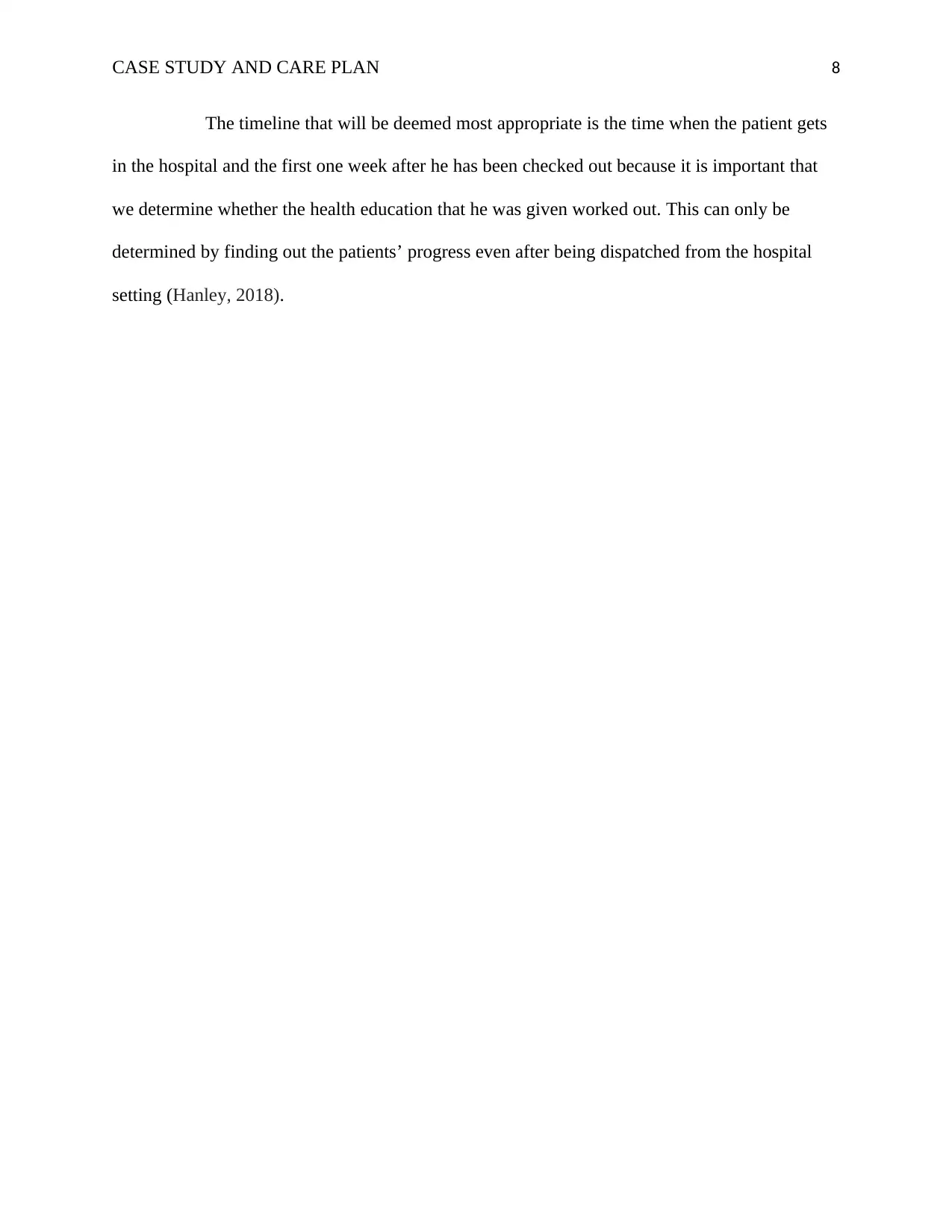
CASE STUDY AND CARE PLAN 8
The timeline that will be deemed most appropriate is the time when the patient gets
in the hospital and the first one week after he has been checked out because it is important that
we determine whether the health education that he was given worked out. This can only be
determined by finding out the patients’ progress even after being dispatched from the hospital
setting (Hanley, 2018).
The timeline that will be deemed most appropriate is the time when the patient gets
in the hospital and the first one week after he has been checked out because it is important that
we determine whether the health education that he was given worked out. This can only be
determined by finding out the patients’ progress even after being dispatched from the hospital
setting (Hanley, 2018).

CASE STUDY AND CARE PLAN 9
References
Ahmed, H., Farewell, D., Francis, N. A., Paranjothy, S., & Butler, C. C. (2018). Risk of adverse
outcomes following urinary tract infection in older people with renal impairment:
Retrospective cohort study using linked health record data. PLoS medicine, 15(9),
e1002652.
Boltz, M., Capezuti, E., Fulmer, T. T., & Zwicker, D. (Eds.). (2016). Evidence-based geriatric
nursing protocols for best practice. Springer Publishing Company.
Butcher, H. K., Bulechek, G. M., Dochterman, J. M. M., & Wagner, C. M. (2018). Nursing
Interventions classification (NIC)-E-Book. Elsevier Health Sciences.
Creutzfeldt, C. J., Kluger, B., Kelly, A. G., Lemmon, M., Hwang, D. Y., Galifianakis, N. B., ...
& Holloway, R. G. (2018). Neuropalliative care: priorities to move the field
forward. Neurology, 91(5), 217-226.
Dang, D., & Dearholt, S. L. (2017). Johns Hopkins nursing evidence-based practice: Model and
guidelines. Sigma Theta Tau.
Drummond, M. F., Sculpher, M. J., Claxton, K., Stoddart, G. L., & Torrance, G. W.
(2015). Methods for the economic evaluation of health care programmes. Oxford
university press.
Dzau, V. J., McClellan, M. B., McGinnis, J. M., Burke, S. P., Coye, M. J., Diaz, A., ... &
Henney, J. E. (2017). Vital directions for health and health care: priorities from a
National Academy of Medicine initiative. Jama, 317(14), 1461-1470.
References
Ahmed, H., Farewell, D., Francis, N. A., Paranjothy, S., & Butler, C. C. (2018). Risk of adverse
outcomes following urinary tract infection in older people with renal impairment:
Retrospective cohort study using linked health record data. PLoS medicine, 15(9),
e1002652.
Boltz, M., Capezuti, E., Fulmer, T. T., & Zwicker, D. (Eds.). (2016). Evidence-based geriatric
nursing protocols for best practice. Springer Publishing Company.
Butcher, H. K., Bulechek, G. M., Dochterman, J. M. M., & Wagner, C. M. (2018). Nursing
Interventions classification (NIC)-E-Book. Elsevier Health Sciences.
Creutzfeldt, C. J., Kluger, B., Kelly, A. G., Lemmon, M., Hwang, D. Y., Galifianakis, N. B., ...
& Holloway, R. G. (2018). Neuropalliative care: priorities to move the field
forward. Neurology, 91(5), 217-226.
Dang, D., & Dearholt, S. L. (2017). Johns Hopkins nursing evidence-based practice: Model and
guidelines. Sigma Theta Tau.
Drummond, M. F., Sculpher, M. J., Claxton, K., Stoddart, G. L., & Torrance, G. W.
(2015). Methods for the economic evaluation of health care programmes. Oxford
university press.
Dzau, V. J., McClellan, M. B., McGinnis, J. M., Burke, S. P., Coye, M. J., Diaz, A., ... &
Henney, J. E. (2017). Vital directions for health and health care: priorities from a
National Academy of Medicine initiative. Jama, 317(14), 1461-1470.
⊘ This is a preview!⊘
Do you want full access?
Subscribe today to unlock all pages.

Trusted by 1+ million students worldwide
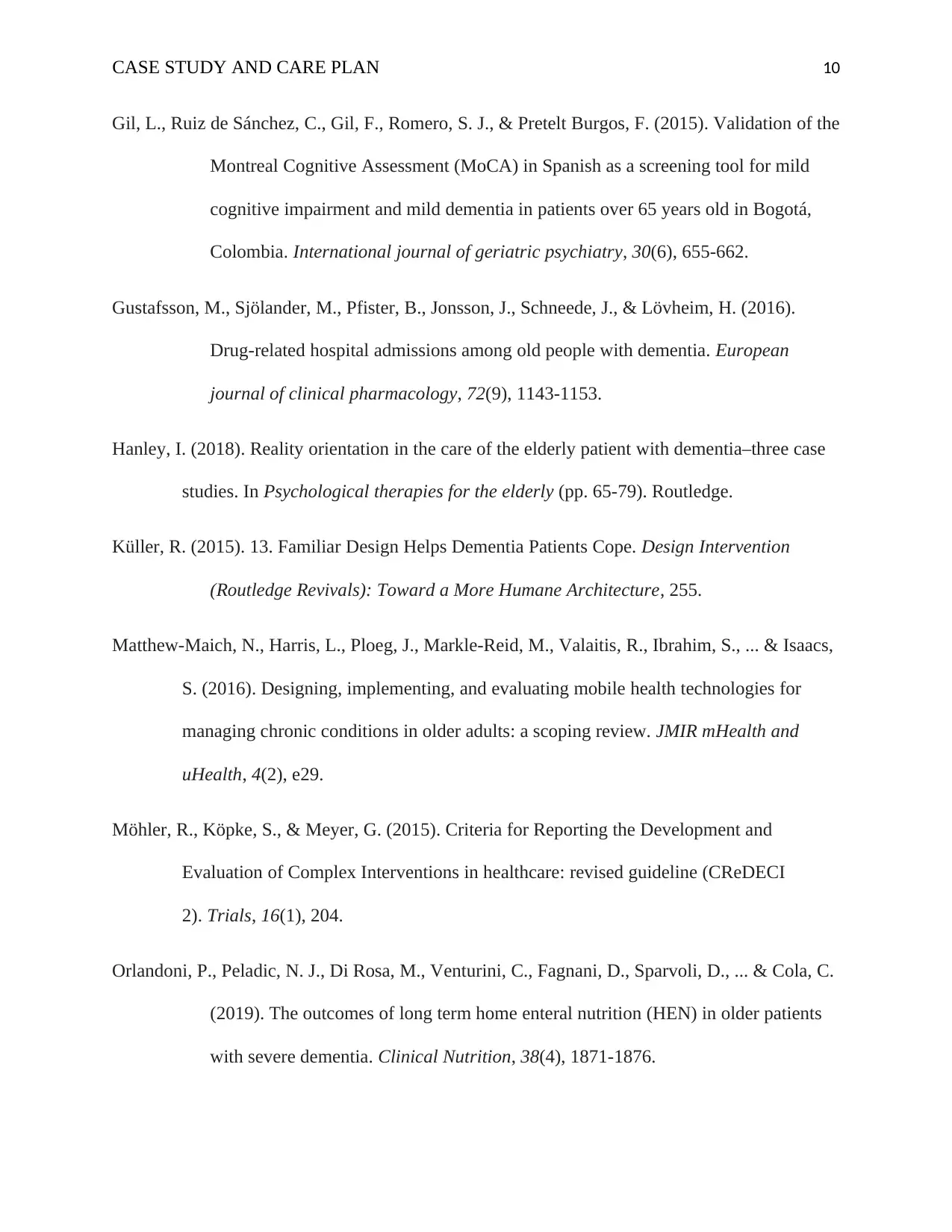
CASE STUDY AND CARE PLAN 10
Gil, L., Ruiz de Sánchez, C., Gil, F., Romero, S. J., & Pretelt Burgos, F. (2015). Validation of the
Montreal Cognitive Assessment (MoCA) in Spanish as a screening tool for mild
cognitive impairment and mild dementia in patients over 65 years old in Bogotá,
Colombia. International journal of geriatric psychiatry, 30(6), 655-662.
Gustafsson, M., Sjölander, M., Pfister, B., Jonsson, J., Schneede, J., & Lövheim, H. (2016).
Drug-related hospital admissions among old people with dementia. European
journal of clinical pharmacology, 72(9), 1143-1153.
Hanley, I. (2018). Reality orientation in the care of the elderly patient with dementia–three case
studies. In Psychological therapies for the elderly (pp. 65-79). Routledge.
Küller, R. (2015). 13. Familiar Design Helps Dementia Patients Cope. Design Intervention
(Routledge Revivals): Toward a More Humane Architecture, 255.
Matthew-Maich, N., Harris, L., Ploeg, J., Markle-Reid, M., Valaitis, R., Ibrahim, S., ... & Isaacs,
S. (2016). Designing, implementing, and evaluating mobile health technologies for
managing chronic conditions in older adults: a scoping review. JMIR mHealth and
uHealth, 4(2), e29.
Möhler, R., Köpke, S., & Meyer, G. (2015). Criteria for Reporting the Development and
Evaluation of Complex Interventions in healthcare: revised guideline (CReDECI
2). Trials, 16(1), 204.
Orlandoni, P., Peladic, N. J., Di Rosa, M., Venturini, C., Fagnani, D., Sparvoli, D., ... & Cola, C.
(2019). The outcomes of long term home enteral nutrition (HEN) in older patients
with severe dementia. Clinical Nutrition, 38(4), 1871-1876.
Gil, L., Ruiz de Sánchez, C., Gil, F., Romero, S. J., & Pretelt Burgos, F. (2015). Validation of the
Montreal Cognitive Assessment (MoCA) in Spanish as a screening tool for mild
cognitive impairment and mild dementia in patients over 65 years old in Bogotá,
Colombia. International journal of geriatric psychiatry, 30(6), 655-662.
Gustafsson, M., Sjölander, M., Pfister, B., Jonsson, J., Schneede, J., & Lövheim, H. (2016).
Drug-related hospital admissions among old people with dementia. European
journal of clinical pharmacology, 72(9), 1143-1153.
Hanley, I. (2018). Reality orientation in the care of the elderly patient with dementia–three case
studies. In Psychological therapies for the elderly (pp. 65-79). Routledge.
Küller, R. (2015). 13. Familiar Design Helps Dementia Patients Cope. Design Intervention
(Routledge Revivals): Toward a More Humane Architecture, 255.
Matthew-Maich, N., Harris, L., Ploeg, J., Markle-Reid, M., Valaitis, R., Ibrahim, S., ... & Isaacs,
S. (2016). Designing, implementing, and evaluating mobile health technologies for
managing chronic conditions in older adults: a scoping review. JMIR mHealth and
uHealth, 4(2), e29.
Möhler, R., Köpke, S., & Meyer, G. (2015). Criteria for Reporting the Development and
Evaluation of Complex Interventions in healthcare: revised guideline (CReDECI
2). Trials, 16(1), 204.
Orlandoni, P., Peladic, N. J., Di Rosa, M., Venturini, C., Fagnani, D., Sparvoli, D., ... & Cola, C.
(2019). The outcomes of long term home enteral nutrition (HEN) in older patients
with severe dementia. Clinical Nutrition, 38(4), 1871-1876.
Paraphrase This Document
Need a fresh take? Get an instant paraphrase of this document with our AI Paraphraser
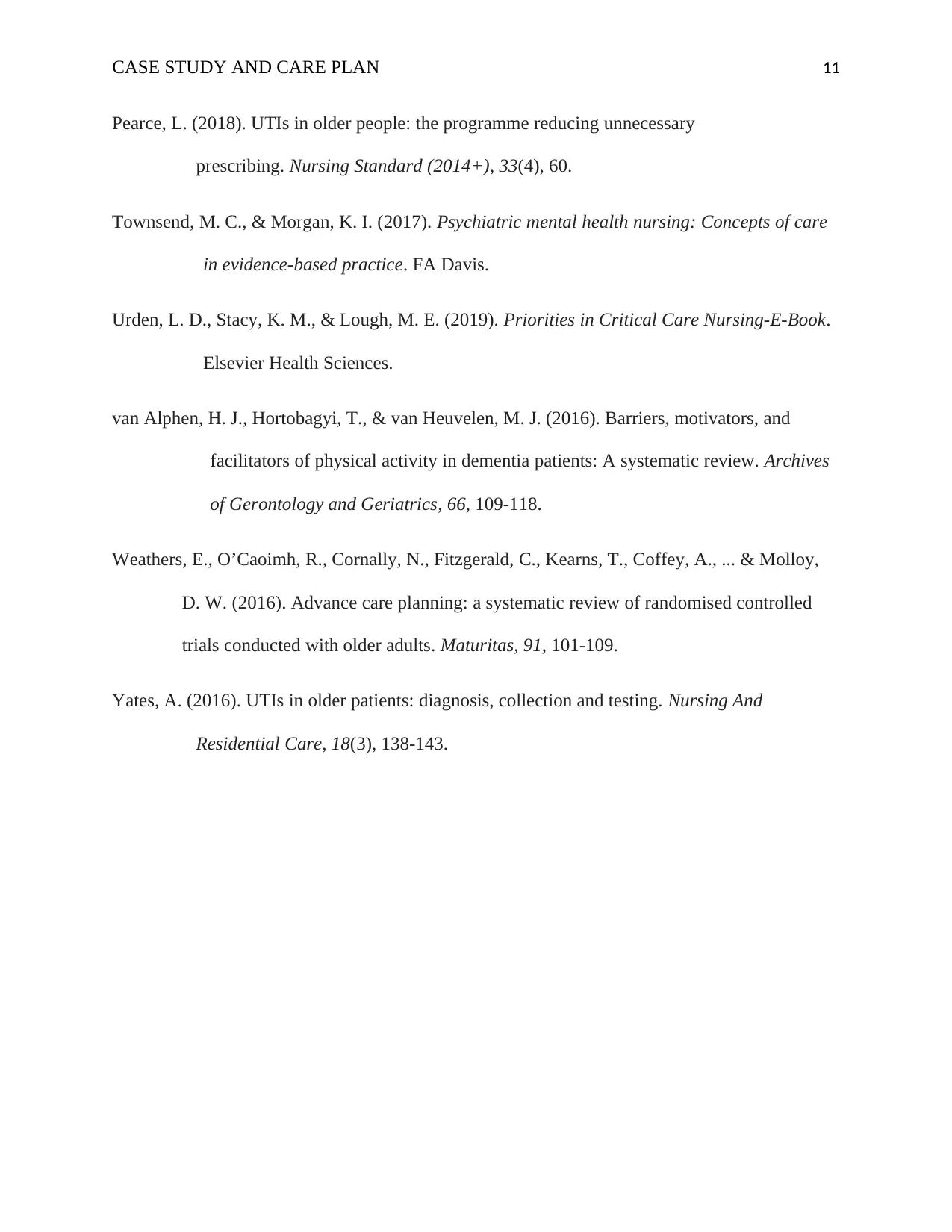
CASE STUDY AND CARE PLAN 11
Pearce, L. (2018). UTIs in older people: the programme reducing unnecessary
prescribing. Nursing Standard (2014+), 33(4), 60.
Townsend, M. C., & Morgan, K. I. (2017). Psychiatric mental health nursing: Concepts of care
in evidence-based practice. FA Davis.
Urden, L. D., Stacy, K. M., & Lough, M. E. (2019). Priorities in Critical Care Nursing-E-Book.
Elsevier Health Sciences.
van Alphen, H. J., Hortobagyi, T., & van Heuvelen, M. J. (2016). Barriers, motivators, and
facilitators of physical activity in dementia patients: A systematic review. Archives
of Gerontology and Geriatrics, 66, 109-118.
Weathers, E., O’Caoimh, R., Cornally, N., Fitzgerald, C., Kearns, T., Coffey, A., ... & Molloy,
D. W. (2016). Advance care planning: a systematic review of randomised controlled
trials conducted with older adults. Maturitas, 91, 101-109.
Yates, A. (2016). UTIs in older patients: diagnosis, collection and testing. Nursing And
Residential Care, 18(3), 138-143.
Pearce, L. (2018). UTIs in older people: the programme reducing unnecessary
prescribing. Nursing Standard (2014+), 33(4), 60.
Townsend, M. C., & Morgan, K. I. (2017). Psychiatric mental health nursing: Concepts of care
in evidence-based practice. FA Davis.
Urden, L. D., Stacy, K. M., & Lough, M. E. (2019). Priorities in Critical Care Nursing-E-Book.
Elsevier Health Sciences.
van Alphen, H. J., Hortobagyi, T., & van Heuvelen, M. J. (2016). Barriers, motivators, and
facilitators of physical activity in dementia patients: A systematic review. Archives
of Gerontology and Geriatrics, 66, 109-118.
Weathers, E., O’Caoimh, R., Cornally, N., Fitzgerald, C., Kearns, T., Coffey, A., ... & Molloy,
D. W. (2016). Advance care planning: a systematic review of randomised controlled
trials conducted with older adults. Maturitas, 91, 101-109.
Yates, A. (2016). UTIs in older patients: diagnosis, collection and testing. Nursing And
Residential Care, 18(3), 138-143.
1 out of 11
Related Documents
Your All-in-One AI-Powered Toolkit for Academic Success.
+13062052269
info@desklib.com
Available 24*7 on WhatsApp / Email
![[object Object]](/_next/static/media/star-bottom.7253800d.svg)
Unlock your academic potential
Copyright © 2020–2025 A2Z Services. All Rights Reserved. Developed and managed by ZUCOL.





